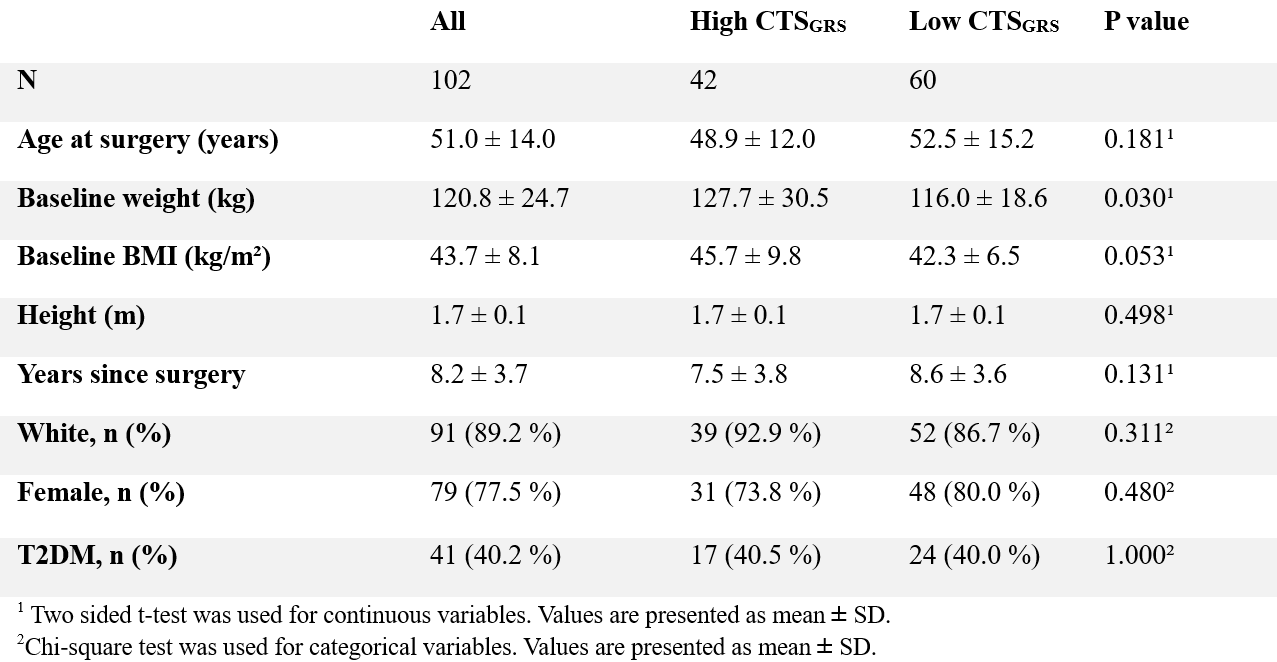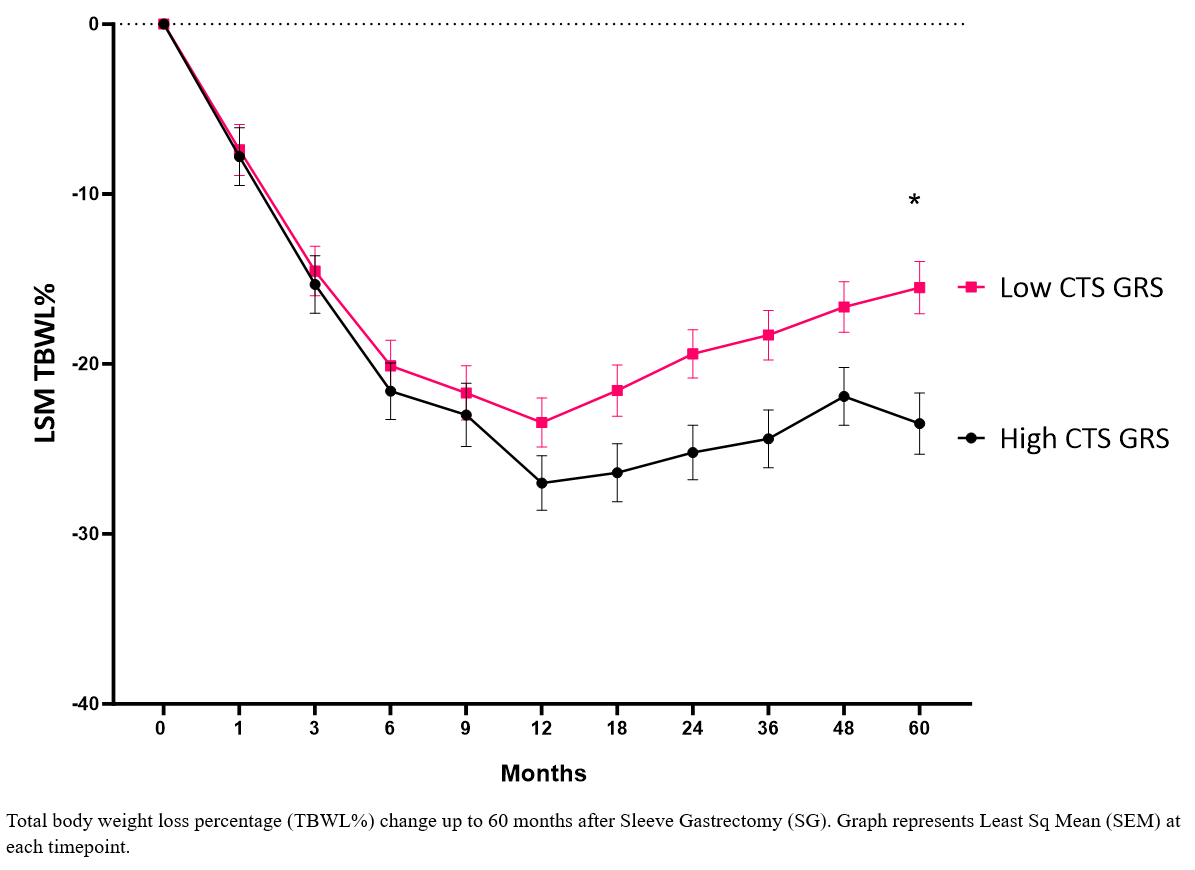Sunday Poster Session
Category: Diet, Nutrition, and Obesity
P0546 - Machine Learning-Assisted Gene Risk Score for Calories to Satiation Predicts Weight Loss Outcomes After Sleeve Gastrectomy
Sunday, October 26, 2025
3:30 PM - 7:00 PM PDT
Location: Exhibit Hall

Maria Antonia Espinosa, MD (she/her/hers)
Mayo Clinic
Presenting Author(s)
Award: ACG Presidential Poster Award
Maria Antonia Espinosa, MD1, Jose Villamarin, MD1, Thomas Fredrick, MD1, Diego Anazco, MD1, Lizeth Cifuentes, MD2, Wissam Ghusn, MD3, Alejandro Campos, MD1, Jacob Bierstedt, MS1, Tim O’Connor, PhD4, Omar M. Ghanem, MD1, Andres Acosta, MD1
1Mayo Clinic, Rochester, MN; 2University of Pittsburgh Medical Center, Pittsburgh, PA; 3Boston Medical Center, Boston, MA; 4Phenomix Sciences, Spokane, WA
Introduction: Sleeve gastrectomy (SG) is among the most performed bariatric procedures. Recently, we developed a genetic risk score to predict calories to satiation (CTSGRS) (PMID 38826309). We aimed to evaluate whether CTSGRS status is associated with weight loss after SG.
Methods: The Mayo Clinic Biobank is a large-scale biorepository of adult patients with genetic whole-exome data. From the Biobank, we identified 102 patients with a history of SG and genetic information available. We estimated the gene risk score as a continuous value and dichotomized it at 0.5 into High CTSGRS and Low CTSGRS. Our primary endpoint was total body weight loss percentage (TBWL%) at 60 months. Secondary outcomes included TBWL% at 1, 3, 6, 9, 12, 18, 24, 36 and 48 months. We used a repeated measures mixed model (REML) to analyze longitudinal TBWL%. The model included random intercepts for each patient and fixed effects for CTSGRS group (High vs. Low), age, sex, and baseline weight. We estimated Least‐squares means (LSM) and standard errors (SEM) and used Tukey HSD for post-hoc multiple comparisons.
Results: Baseline age, sex, and BMI were similar between High (n = 42) and Low (n = 60) CTSGRS groups; only baseline weight was higher in High CTSGRS (127.7 ± 30.5 vs. 116.0 ± 18.6 kg; p = 0.030; Table 1). In the mixed‐effects model, the CTSGRS × timepoint interaction was highly significant [F(10, 700) = 2.78; p < 0.001], indicating that weight‐loss trajectories differed by CTSGRS group over time. Patients with a High CTSGRS consistently lost more weight at each timepoint. At 60 months, TBWL% was -29.4 ± 2.1% in High CTSGRS vs. -22.1 ± 1.3% in Low CTSGRS (padj = 0.047; Figure 1).
Discussion: Patients with a High CTSGRS demonstrated significantly greater TBWL% up to 5 years postoperatively. A polygenic background, represented by the CTSGRS, might influence weight loss outcomes in sleeve gastrectomy. Incorporating genetic predictions may help tailor follow-up interventions and optimize postoperative outcomes.

Figure: Table 1: Baseline Characteristics at Surgery

Figure: Figure 1: Predicted Total Body Weight‐Loss (%) Over Time After SG Stratified by CTSGRS
Disclosures:
Maria Antonia Espinosa indicated no relevant financial relationships.
Jose Villamarin indicated no relevant financial relationships.
Thomas Fredrick indicated no relevant financial relationships.
Diego Anazco indicated no relevant financial relationships.
Lizeth Cifuentes indicated no relevant financial relationships.
Wissam Ghusn indicated no relevant financial relationships.
Alejandro Campos indicated no relevant financial relationships.
Jacob Bierstedt indicated no relevant financial relationships.
Tim O’Connor: Phenomix Sciences – Employee.
Omar Ghanem indicated no relevant financial relationships.
Andres Acosta: Phenomix sciences – Royalties. Rhythm Pharmaceuticals, Gila Therapeutics, Amgen, General Mills, Regeneron, Boehringer Ingelheim, Novo Nordisk, Currax, Nestlé, Phenomix Sciences – Consultant, Grant/Research Support.
Maria Antonia Espinosa, MD1, Jose Villamarin, MD1, Thomas Fredrick, MD1, Diego Anazco, MD1, Lizeth Cifuentes, MD2, Wissam Ghusn, MD3, Alejandro Campos, MD1, Jacob Bierstedt, MS1, Tim O’Connor, PhD4, Omar M. Ghanem, MD1, Andres Acosta, MD1. P0546 - Machine Learning-Assisted Gene Risk Score for Calories to Satiation Predicts Weight Loss Outcomes After Sleeve Gastrectomy, ACG 2025 Annual Scientific Meeting Abstracts. Phoenix, AZ: American College of Gastroenterology.
Maria Antonia Espinosa, MD1, Jose Villamarin, MD1, Thomas Fredrick, MD1, Diego Anazco, MD1, Lizeth Cifuentes, MD2, Wissam Ghusn, MD3, Alejandro Campos, MD1, Jacob Bierstedt, MS1, Tim O’Connor, PhD4, Omar M. Ghanem, MD1, Andres Acosta, MD1
1Mayo Clinic, Rochester, MN; 2University of Pittsburgh Medical Center, Pittsburgh, PA; 3Boston Medical Center, Boston, MA; 4Phenomix Sciences, Spokane, WA
Introduction: Sleeve gastrectomy (SG) is among the most performed bariatric procedures. Recently, we developed a genetic risk score to predict calories to satiation (CTSGRS) (PMID 38826309). We aimed to evaluate whether CTSGRS status is associated with weight loss after SG.
Methods: The Mayo Clinic Biobank is a large-scale biorepository of adult patients with genetic whole-exome data. From the Biobank, we identified 102 patients with a history of SG and genetic information available. We estimated the gene risk score as a continuous value and dichotomized it at 0.5 into High CTSGRS and Low CTSGRS. Our primary endpoint was total body weight loss percentage (TBWL%) at 60 months. Secondary outcomes included TBWL% at 1, 3, 6, 9, 12, 18, 24, 36 and 48 months. We used a repeated measures mixed model (REML) to analyze longitudinal TBWL%. The model included random intercepts for each patient and fixed effects for CTSGRS group (High vs. Low), age, sex, and baseline weight. We estimated Least‐squares means (LSM) and standard errors (SEM) and used Tukey HSD for post-hoc multiple comparisons.
Results: Baseline age, sex, and BMI were similar between High (n = 42) and Low (n = 60) CTSGRS groups; only baseline weight was higher in High CTSGRS (127.7 ± 30.5 vs. 116.0 ± 18.6 kg; p = 0.030; Table 1). In the mixed‐effects model, the CTSGRS × timepoint interaction was highly significant [F(10, 700) = 2.78; p < 0.001], indicating that weight‐loss trajectories differed by CTSGRS group over time. Patients with a High CTSGRS consistently lost more weight at each timepoint. At 60 months, TBWL% was -29.4 ± 2.1% in High CTSGRS vs. -22.1 ± 1.3% in Low CTSGRS (padj = 0.047; Figure 1).
Discussion: Patients with a High CTSGRS demonstrated significantly greater TBWL% up to 5 years postoperatively. A polygenic background, represented by the CTSGRS, might influence weight loss outcomes in sleeve gastrectomy. Incorporating genetic predictions may help tailor follow-up interventions and optimize postoperative outcomes.

Figure: Table 1: Baseline Characteristics at Surgery

Figure: Figure 1: Predicted Total Body Weight‐Loss (%) Over Time After SG Stratified by CTSGRS
Disclosures:
Maria Antonia Espinosa indicated no relevant financial relationships.
Jose Villamarin indicated no relevant financial relationships.
Thomas Fredrick indicated no relevant financial relationships.
Diego Anazco indicated no relevant financial relationships.
Lizeth Cifuentes indicated no relevant financial relationships.
Wissam Ghusn indicated no relevant financial relationships.
Alejandro Campos indicated no relevant financial relationships.
Jacob Bierstedt indicated no relevant financial relationships.
Tim O’Connor: Phenomix Sciences – Employee.
Omar Ghanem indicated no relevant financial relationships.
Andres Acosta: Phenomix sciences – Royalties. Rhythm Pharmaceuticals, Gila Therapeutics, Amgen, General Mills, Regeneron, Boehringer Ingelheim, Novo Nordisk, Currax, Nestlé, Phenomix Sciences – Consultant, Grant/Research Support.
Maria Antonia Espinosa, MD1, Jose Villamarin, MD1, Thomas Fredrick, MD1, Diego Anazco, MD1, Lizeth Cifuentes, MD2, Wissam Ghusn, MD3, Alejandro Campos, MD1, Jacob Bierstedt, MS1, Tim O’Connor, PhD4, Omar M. Ghanem, MD1, Andres Acosta, MD1. P0546 - Machine Learning-Assisted Gene Risk Score for Calories to Satiation Predicts Weight Loss Outcomes After Sleeve Gastrectomy, ACG 2025 Annual Scientific Meeting Abstracts. Phoenix, AZ: American College of Gastroenterology.

